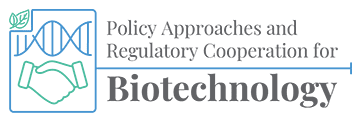Description
Alignment of policies and procedures is in itself an approach to regulatory cooperation and it can be necessary and important step toward achieving other forms of regulatory cooperation, in particular for efforts to harmonize risk/safety assessments among member economies, as discussed in the next section on collaboration on risk/safety assessments. Depending on the reason for cooperating, policy alignment can be pursued at different levels. High level policy alignment and lower-level technical policy alignment are discussed here.
High Level Policy Alignment
High level policy alignment may be the easiest to achieve. Most economies will have established a similar high-level policy for biotechnology, along the lines of ‘to realize the potential benefits pf biotechnology while ensuring safety for humans and the environment, organisms derived using modern biotechnology are subject to risk/safety assessment prior to introduction to the market’. This is also consistent with the international obligations for economies that are party to the Cartagena Protocol on Biosafety under the Convention on Biotechnology. However, if economies will strive to achieve policy alignment at a lower level, such as technical policies or policies to streamline regulatory cooperation, it is essential to acknowledge alignment of higher-level policies first. The existence of the APEC High Level Policy Dialogue on Agricultural Biotechnology suggests there is already at least some degree of high-level policy alignment within APEC economies.
Technical Policy Alignment
At another level, technical policies are the ‘mechanisms’ put in place to accomplish higher level policies. Technical policies may refer to administrative procedures or scientific technical procedures such as those for risk/safety assessment. Administrative procedures include defined timelines for issuing decisions or defined steps and required committees for reviewing applications. Alignment of administrative procedures may not be necessary for regulatory cooperation although it will always be important to carefully consider similarities and acknowledge differences in administrative procedures before economies embark on efforts to align technical policies for risk/safety assessments.
Technical policies related to risk/safety assessment include methodologies or ways to conduct risk/safety assessments and scientific or technical requirements for generating information or evidence in support of an assessment. Most experienced regulatory systems will have established ‘tools’ for risk/safety assessment that can be used as a basis for comparison and a catalyst for alignment among economies, such as guidance on the conduct of assessments, agreements on the types of information (data) needed to inform risk/safety assessments, criteria for data acceptance or guidelines for testing, or standardized templates for application or data submission. Alignment of risk/safety assessment policies may be the most impactful approach to regulatory cooperation, but also bring significant challenges, as discussed in more detail in the section on risk/safety assessment collaboration.
Alignment of Streamlined Policies
As biotechnology regulatory systems mature, experience makes it possible to streamline or modify policies in ways that employ faster or simpler methods to make the systems more efficient and effective. Policies may be streamlined for assessment and decision making, for example, in the cases of products that have been subject to earlier reviews or products that have other risk/safety mitigating properties. Simplified procedures represent another opportunity for policy alignment among member economies. In some cases, economies can consider alignment of a simplified procedure for certain cases even when there is not alignment of the more complex policies in each economy.
A good example of regulatory cooperation through the alignment of streamlined policies is the declaration on new breeding techniques signed in 2017 by the Ministers of Agriculture from Argentina, Brazil, Chile, Paraguay, and Uruguay, specifically with the goal to exclude certain gene edited products from strict regulation by adopting common streamlined policies (Turnbull et al. 2021). Among the economies in Latin America, Colombia, Honduras, and Ecuador have also drafted legislation for this purpose. In the case of Ecuador, the constitution does not allow cultivation of GM crops unless the president deems it to be in the interest of the nation, but the Ecuadorian government implemented a decree in 2019 excluding certain gene edited products from regulations associated with GMOs, similar to other economies.
International Policy Alignment
When member economies policies are aligned with established and accepted international policies, the alignment of policies between member economies becomes much more straightforward. Several international forums provide guidance and information that support consistent policies and assessments. Some of these are listed below:
- Codex Alimentarius
- OECD Working Party on Safety of Novel Foods and Feeds
- OECD Working Party on Harmonisation of Regulatory Oversight in Biotechnology
- International Plant Protection Convention
- World Organization for Animal Health
- Cartagena Protocol Annex III
APEC member economies may also work toward aligned policies and approaches through participation in international capacity building programs. For example, the Food and Agriculture Organization (FAO) conducts biosafety capacity building as part of its efforts to improve food security and agricultural practices globally. There are also a number of capacity building programs associated with the implementation of the Cartagena Protocol on Biosafety, including those supported by the United Nations Environmental Programme (UNEP) and Global Environment Fund (GEF). Capacity building programs exist to provide support for policy development, risk assessment training, development of biosafety guidelines, and some to foster regional cooperation specifically.
